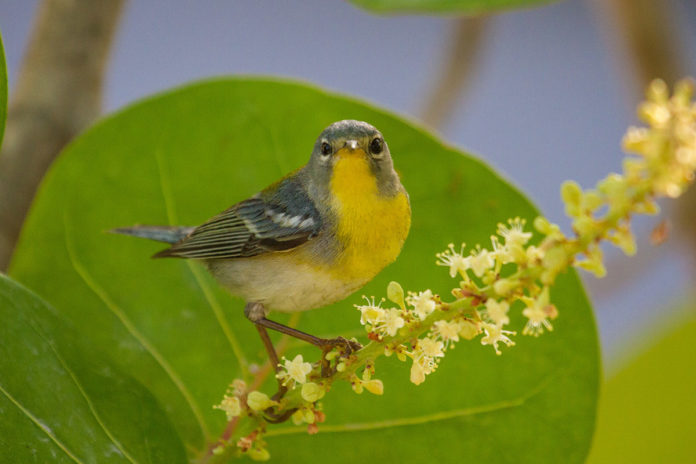There’s an oft-quoted line from “To Kill A Mockingbird”: “Mockingbirds don’t do one thing but make music for us to enjoy … but sing their hearts out for us. That’s why it’s a sin to kill a mockingbird.”
I mean, it’s a lovely sentiment, and a poignant metaphor that plays out throughout the book, but the problem is, it wouldn’t hold up in bird court. It’s the repeated phrase “for us” that’s the rub because, like more things than we care to admit in the world, it’s not really about us humans. (Though, to be clear, it is still a sin to kill a mockingbird.)
Bird song, as far as we know, tends to be motivated by two things: sex and real estate.
If their songs had lyrics, the essential themes would be: “This place is mine mine mine/stay out out out,” or “Hey! You, with all the pretty feathers! Let’s combine our genetic materials and send them out into the universe!”
Most bird songs are performed by males, but it’s been noticed, of late, that some female birds sing, too, though the understanding of the nuances of these songs and why they are sung, has generally been blotted out by male-oriented myopia in the field of ornithology. (This will no doubt be a shock to most women.)
Bird song is most intense in the spring, which is just beginning. You hear rapturous descriptions from people up north about the auditory cacophony that tends to start everyone’s day.
It’s not something that really happens here. An estimated 250 or so species of birds have been recorded in the Florida Keys, but only about 40 of them breed here, and most do not sing.
While places up north tend to get a Mormon Tabernacle’s worth of bird song in the morning, our soundscape is closer in volume to a show tunes vocal ensemble in a poorly attended regional school district. Which is not to say the players are not accomplished.
Mockingbirds, with their infinite ability to scat and mimic, seem to dominate, issuing endless phrases both familiar and not. They tend to get underscored by the four or five species of doves we have nesting here. Prairie warblers will add their high, rising and quickening series of syllables – usually about seven – to the mix, and black-whiskered vireos do this two-note-by-two-note question-and-answer thing. Up the Keys you get northern cardinals and, once in the bluest of moons, a mangrove cuckoo.
All this gets punctuated by the referee whistle calls of gray kingbirds.
But that’s about it for bird song in these parts.
We do get other noises – the ragged honks of herons, the not-laughing-with-you calls of laughing gulls, etc. – but these are more reactions or exclamations than songs.
Most of the songbirds that winter here don’t breed here, so they need not mark territory or attract a mate with a song. But they’re not silent, either. They give little chip notes, also known as contact calls. It’s a way for their foraging buddies to know where they are without everyone having to keep an eye on each other. Conchs sometimes refer to these birds as “chip chips,” which is one of my favorite local nicknames. (As opposed to Cuban finches, which is a rant for a different day.)
Gray catbirds are the one exception. They don’t sing full-throated, but start practicing while they’re here, muttering softly to themselves as they hop around in the bushes.
Once you start paying attention to bird songs in the Keys, it doesn’t take long to become familiar with the regulars. And when you hear something unfamiliar, it can feel seismic.
It happened to me the other day. I was working in the backyard when I heard it, this quick, full rise and fall of a song. It was high, sweet, crenelated and round at the same time – and, like a lot of bird songs, something that was clear in my head but totally resistant to any description that would put a clear idea into anyone else’s head, even if you did something humiliating, like attempt to sing it.
I looked up and saw two or three small birds flitting about in the mahogany tree, then heard the song again, then again.
One more time and I’m getting my binoculars, I thought. But that was it; the bird did not sing again. And I was left with a small hole in my soul — created by the thought that the bird world had offered me something new, and I wasn’t ready for it. What if I was unfamiliar with the sound because it was a rare bird that wasn’t here very often? Or ever?
This gnawed at me for close to a week until I was drinking coffee on the front porch one morning and heard it again – a quick rise and fall, a few dozen vibrating syllables packed into one sliding note.
I didn’t hesitate. I went in, grabbed my binoculars and wandered barefoot around the neighborhood in the clothes I had slept in.
There was a trio of birds out there – a palm warbler, a yellow-rumped warbler, and a northern parula.
It was a bit of a shell game. I was staring at the palm warbler when I heard the song again, but his mouth didn’t move. I switched to the yellow-rump, heard the song, and saw no movement there, either. That left the northern parula, with its blue wings, yellow belly and white wing bars – a bird I’d seen a kajillion times, but never before heard sing, until he opened his mouth again and let fly.
I watched him cycle through his refrain four or five times, having no idea why he’d chosen to sing there, a few months south of his breeding range, and then, a few months early. But I appreciated him restoring my sense of minimal competency as a birder.
I haven’t heard him since.


























